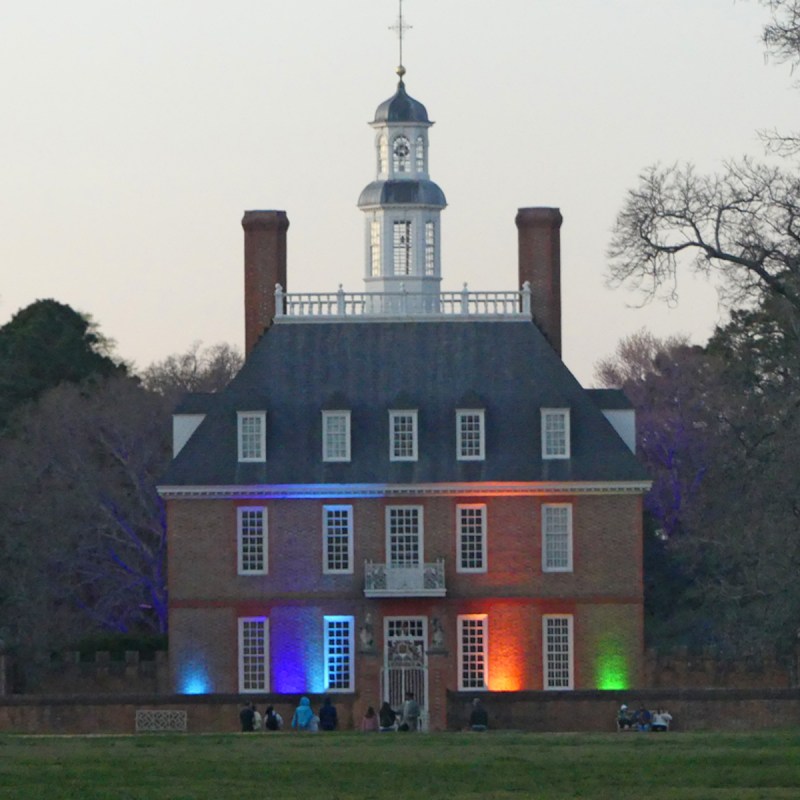
Few places take you back to the past like Williamsburg, Virginia. It began as the Middle Plantation between 1630 and 1633 when some Jamestown settlers moved there. When the Jamestown capital burned, a temporary capital was built at Middle Plantation. When the Jamestown’s capital burned again in 1698, they decided to permanently move it to Middle Plantation and renamed it Williamsburg, in honor of King William III. After then Governor Thomas Jefferson moved the capital to Richmond, Williamsburg became a sleepy village.
Videos by TravelAwaits
In the 20th century, tourism led to rebirth. Today, Colonial Williamsburg is Virginia’s most popular tourist destination. There’s a good reason why. Where else can you meet famous characters from history? I met the Marquis de Lafayette. You may run into George Washington, or dozens of people that figured in the American Revolution.
This was a hosted trip, but all opinions are my own.

1. Capitol
The Capitol is the most impressive building in Williamsburg. It’s built in a Georgian style and has twin apses, curved turret-like buildings, and a joining middle section. It’s not the original but an authentic recreation of the first capital built in 1705.
Our guide started in the section used as a court and took us through the general assembly sections. She gave sample demonstrations of the activities carried on in each of the sections, letting us act as participants in making early Virginia laws. An interesting historical fact about the Capitol: On June 29, 1776, Virginians declared independence from Great Britain and wrote Virginia’s first constitution 4 days before Congress voted for the Declaration of Independence.
The most interesting event is Cry Witch held at the Capitol at night. We attended a mock trial of Grace Sherwood, the so-called Witch of Pungo. The actors portraying the judge, district attorney, Grace, and witnesses were so talented. During the trial, the judge called on the audience to ask questions, and after they heard the witnesses, he allowed us to vote. Grace was found guilty by a 42 to 40 vote.
Pro Tip: Colonial Williamsburg is walkable, but there’s a free shuttle every 15 minutes from 9 a.m. until 10 p.m. with eight stops around the district.

2. Governor’s Palace
The Governor’s Palace, also a replica of the original that was burned down, has Palace Green, a lovely green space in front of it. It’s surrounded by gardens and outbuildings which I self-toured. To enter the palace, I took my spot on a bench outside the gate while a docent gave some basic facts. Then another docent took us through the building, explaining what they used each room for. Few people entered past the entry hall and adjourning offices in those days. The elites who were invited to the balls danced until dawn. Our docent explained why no one wanted to be the first to leave, because as soon as they left, the other guest would begin gossiping about them. Some things never change.

3. Archaeology Sites
Williamsburg prides itself on being historically accurate. Archaeologists use evidence matched with historical documents and images to create the town as it really was. One important place they’re excavating is the site of two African American Baptist churches. The mid-19th century First Baptist Church was torn down, as it portrayed a later time. Now, they are excavating an earlier, smaller building beneath that church. Constructed in the mid-1700s, it’s believed to be one of the oldest African American churches in the country.
There is an exhibit telling the church’s history in the Taliaferro Cole Stable across the street.
Custis Square, catty-corner from the church site, is another archaeological site where John Custis IV’s home and gardens once stood. Custis was the father of Daniel Custis, Martha Washington’s first husband. John was an avid gardener and had many unusual plants. The dig has recovered many artifacts, including old wine bottles, coins, and more.

4. Randolph House And Yard
The dark-red-framed Peyton Randolph House, built in 1715, is one of the oldest houses in Colonial Williamsburg. It was the home of Peyton Randolph, President of the First and Second Continental Congresses, and his wife, Elizabeth. They used it as a hospital to treat wounded soldiers during the Revolution. It has the reputation as the most haunted house in the U.S. Lafayette stayed two nights here on his visit to the U.S. in October 1824. He wrote of strange paranormal events happening to him there.
The Randolph Yard showcases the lives of the enslaved people who worked here. A docent showed us the kitchen where Betty, the cook, and her helpers labored.
5. Tradesmen
Throughout the Historic District, there are places where various tradesmen worked and we visited several. The tailor and his journeyman explained how they made clothes for the town. The blacksmith shop was busy with several smiths toiling at the forges. There are tinsmiths, cabinet makers, builders, apothecaries, hatmakers, wigmakers, and more.
At the Charlton Stage, you can learn a trade, meet a nation-maker in person, learn about American Indian life, and much more here.

6. Public Gaol
This was where debtors and criminals were imprisoned. Some of Blackbeard’s pirates were held here before their hangings. The cells make you want to stay law-abiding.
7. Bruton Parish Church
This was the area’s official Episcopal church, and they expected all Virginians to attend regularly. It is still an active church with a small museum and gift shop on the same block.
8. Historic Gardens
Throughout the district, there are several historic gardens with docents to tell you about the crops grown then. We saw many of the farm animals, including sheep and horses, that pull the historic carriages you can book to tour the village.
Pro Tips: You can walk around the district for free but need to purchase a ticket for entry into buildings at the visitor center. Additional tours are available to purchase.
9. Haunted Williamsburg Ghost Tour
The night we took the ghost tour, it rained, so we didn’t get the full experience. Even so, it was fascinating, and Iris, our guide, told many stories about the places in the district, including personal experiences and encounters by staff members.

10. Merchants Square
Merchants Square, at the end of the Historic District, offers modern shops, dining, and Kimball Theater.
11. Art Museums
The art museums are filled with multiple galleries ranging from folk art to objects from Colonial Williamsburg. Some collections I visited were A Gift to the Nation, Navajo Weavings: Adapting Tradition, Art of the Quilter, and American Folk Pottery.
12. Golden Horseshoe Golf Club
The courses here were designed by the father-and-son team of Robert Trent Jones Sr. and Rees Jones. We took a golf cart tour of the course, and even though I am not a golfer, the beauty of the course is impressive. There is only nature surrounding the course, not subdivision homes. Hole 16, an island green we stopped at, has been compared to Augusta’s, where the Masters takes place.

13. Spa
The Spa of Colonial Williamsburg is a treat to the mind and body. Besides the traditional spa facilities, steam rooms, showers, and whirlpools, which exceed any I’ve ever visited, they have hair and nail salons, a well-equipped fitness center, indoor pool, family pool, and tranquility pool for adults only. I had an aromatherapy massage.
The spa offered robes, slippers, and a private locker. Clint, my masseur, had magic hands and I left feeling like all my muscles had been returned to a perfect state. We enjoyed the Spa Food Package of a charcuterie board and an equally delicious dessert board.
14. Kings Arms Tavern
Since Jane Vobe opened the original tavern in 1772, this authentic reproduction of a public house serves 18th century food tailored to meet modern-day tastes. The décor is authentic and the servers dress in period costumes. John, our server, was amazing with his knowledge of the way they did things at the original tavern. With each course, he gave us detailed stories about the food and culture. Peanut Soupe — spelling on the menu is true to the times — was a popular item then. I had the Smoked Golden Yard Bird for my entrée and it was superb! John assured us that people from those times ate dessert to clean the palate, so I followed his advice. The pecan pie with butter pecan ice cream refreshed my palate.
15. Terrace Room
The Terrace Room is in the Williamsburg Inn where Queen Elizabeth II stayed when she visited Williamsburg. I started with the shrimp cocktail and had the maple mustard glazed Duroc pork tenderloin. Dessert was bananas Foster crème brûlée. The food and atmosphere are fit for royalty.

16. Sweet Tea And Barley
On our last day in Williamsburg, we dined at the Sweet Tea and Barley in Williamsburg Lodge where we stayed — another cozy place with an 18th century feel. I started with Chesapeake crab chowder, then had shrimp and grits for my entrée. Dessert was spiced bread pudding with vanilla ice cream — so delicious.
Pro Tip: Williamsburg Lodge, bordering the Historic District, is a wonderful place to stay. There’s a shuttle stop in front. I loved my room in the Ashby Guest House with modern amenities set in a 17th century-style building.
Be sure to visit the many historic towns that Virginia has to offer:
